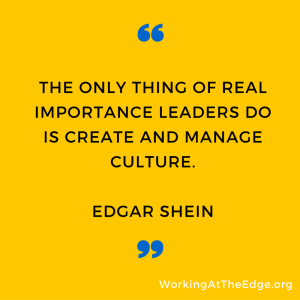 This is the second in a series of four posts that have emerged as a result of a week-long trip to Silicon Valley with a group of educational leaders from the University of Pennsylvania Midcareer Doctoral Program in Educational Leadership. Be sure to check out previous blog posts providing my reflections on the daily adventures. You can find the previous posts in this series at these links:
This is the second in a series of four posts that have emerged as a result of a week-long trip to Silicon Valley with a group of educational leaders from the University of Pennsylvania Midcareer Doctoral Program in Educational Leadership. Be sure to check out previous blog posts providing my reflections on the daily adventures. You can find the previous posts in this series at these links:
It’s a common understanding among leaders that one of the primary roles of leadership is the shaping of culture. Supporting this understanding is a quote from Edgar Shein, former professor at the MIT Sloan School of Management, “The only thing of real importance leaders do is create and manage culture.”
As leaders, when we visit progressive schools such as Brightworks or the AltSchool, we may feel inspired, but we also have to be realistic that any systemic transformation is much more complicated that transplanting a model from one system to another. A more effective way to approach transformation is for school leaders to be inspired by these progressive models but then ask questions such as the one I was asking myself on the recent #PennSV16 trip:
What cultural signs foster the adoption of innovations (the uncommon dots) in education?
I was most fascinated by Brightworks, a maker/tinkering school developed from the work of Gever Tully. As I watched the learners in this environment, I wondered what aspects of this school could be embraced by our own comprehensive public school setting and culture. What aspects of our school/district culture could support furthering making/tinkering and other such innovations?
Here is a short list of 4 cultural signs that can push educational innovation:
- Inquiry is king. No surprise; I championed inquiry in an earlier post. As curious leaders always on the lookout for innovations and new ideas, we discover things and ask questions. We create space for new conversations. Reflection. Learning. In Salisbury, we have been reinforcing a culture of inquiry around innovation through our visioning process, asking stakeholders what knowledge, skills and dispositions graduates will need for success in a networked ecology. The work of Education Reimagined (check out the podcast) has helped us support this culture of inquiry and do this work. (I look forward to writing a post on the process we have followed for defining our profile of a graduate and beliefs about learning.)
- Understand that innovation is relative to context. A.J. Juliani wrote a blog post recently where he shared, “If it’s a new idea to you and your students and it works in your class then it’s innovative.” I fully agree. The meaning of “innovation” gets to be defined by the user. It’s relative to context. This year, we gathered 15 of our most innovative teachers for a year-long exploration of innovation. The work they have done spans the range of innovation – from genius hour and project-based learning to making/tinkering. What we have realized is that “innovation” depends on where the innovating teacher is on their journey.
- Iteration is accepted and expected. Iteration is most often referred to as “failure,” but I think “iteration” is a better term. It’s less threatening – less of a culture killer. As leaders we need to send the message to our teachers that it’s OK if a project or “innovation” flops, as long as there is learning from the process that leads to the next iteration. From our critical factors of success project, we have learned the importance of leaders fostering a culture of risk-taking. In a recent podcast interview (to be posted in a few days), Suzie Boss suggested having a “fail fair” where educators share something that just didn’t go as planned. This is a unique activity that will surely foster a culture where iteration is accepted and expected. I’m sure it also provides levity for an otherwise serious conversation!
- Current innovations are spotlighted. Teaching is often described as isolating. Leaders can break this isolation and ignite further iterations in innovation by spotlighting innovations already occurring in the classroom. In Salisbury, we do this through social media using the #stsdlearns hashtag and blogs including SalisburySD.US and TL2020.org.
As a leader, how do you create and manage a culture of innovation? What other cultural signs would you add to this short list?
Connect with Randy on Twitter and on the TLTalkRadio podcast!
Get new content delivered to your inbox and the ebook 3 Key Principles of Digital Transformation. The ebook contains valuable information from my experience leading a digital transformation and working with a variety of stakeholders over the past decade.
- A silver lining - January 22, 2022
- Is our use of tech working against us? 🤔 - September 8, 2021
- What’s NOT going to change in the next 10 years? 🤔 - September 7, 2021
[…] 4 cultural signs you’re ready to push innovation […]